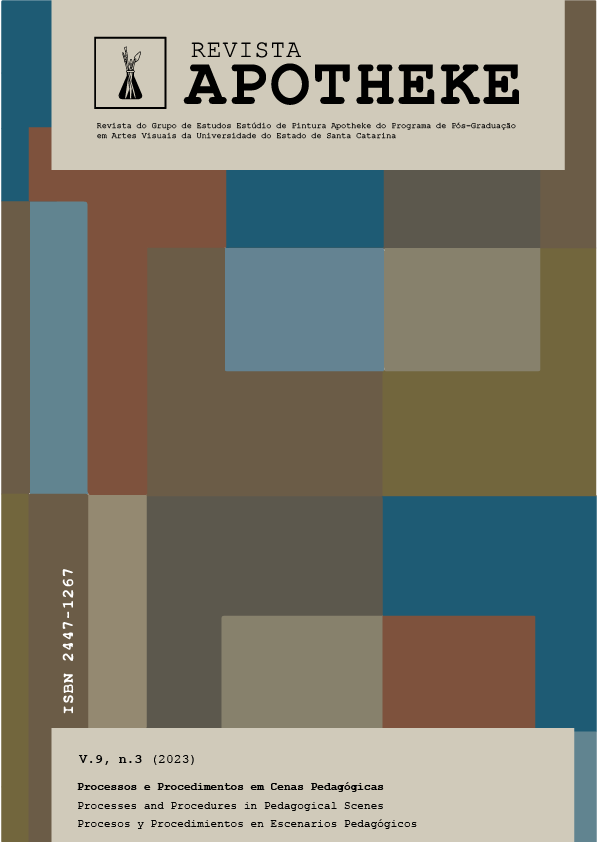Líneas, rostros y mascarillas quirúrgicas: dibujos en la pandemia SARS-CoV-2/Covid-19
DOI:
https://doi.org/10.5965/24471267932023152Palabras clave:
dibujo, rostro, identidad, expresión visual, Pandemia de Covid-19Resumen
La pandemia de Covid-19 cubrió los rostros con mascarillas protectoras, de diferentes formatos y tipologías, que transformaron la visibilidad de la expresión facial humana. Los dibujos de observación presentados aquí son instantáneas de esta reconfiguración, llevada a cabo en Lisboa a partir de 2020, durante mi vida diaria durante la pandemia. Apuntes rápidos de desconocidos en espacios públicos, registrados in situ, en cuadernos u hojas sueltas, con materiales que tenía a mano (o en el bolsillo). La simplicidad de la línea permitió la urgencia de la velocidad de dibujo para reducir lo pudor de la fijación ocular, en un contexto de salud pública vulnerable. El modelado geométrico de la mascarilla rompió con el canon de proporciones, y cambió la expresión y los elementos mínimos de reconocimiento facial. La relación compositiva ojos-nariz-labios desapareció, para dar paso a otras entidades: mirada-ceja, trapecio de la frente, marco del cabello, orejas-colgador y cuello-pedestal. En el nuevo orden visual, el conflicto entre identidad y abstracción despertó los valores simbólicos, sociales y culturales del uso de mascarillas en la construcción de la personalidad, en la representación de narrativas y en la opresión de derechos y libertades.
Descargas
Citas
CAMUS, Albert. A Peste. Porto: Livros do Brasil/ Porto Editora, 2021.
FAU, Julien. Human Anatomy for Artists. Mineola, New York: Dover Publications Inc., 2009.
GIORDANO, Paolo. Frente ao Contágio. Lisboa: Relógio D’Água, 2020.
GÓGOL, Nikolai. O Nariz. Lisboa: Assírio e Alvim, 2007.
IKE, John David; BAYERLE, Henry; LOGAN, Robert A.; PARKER, Ruth M. Face Masks: Their History and the Values They Communicate. Journal of Health Communication, v. 25, n. 12, p. 990-995, 2020.
ISKR, Andrej; GABRIJELCIC, Helena. Eye-tracking analysis of face observing and face recognition. Journal of Graphic Engineering and Design, v. 7, n. 1, p. 5-11, 2016.
KRASTEV, Ivan. O Futuro por Contar: Como a Pandemia Vai Mudar o Mundo. Lisboa: Objetiva, 2020.
MARTINELLI, Lucia; KOPILAS, Vanja; VIDMAR, Matjaz; HEAVIN, Clara; MACHADO, Helena; TODOROVIC, Zoran; BUZAS, Norbert; POT, Mirjam; PRAINSACK, Barbara; GAJOVIC, Srecko. Face Masks During the COVID-19 Pandemic: A Simple Protection Tool With Many Meanings. Frontiers in Public Health, v. 8, n. 606635, p. 1-12, 2021.
SARAMAGO, José. As máscaras que se olham. JL- Jornal de Letras, Artes e Ideias, p. 12, 26 nov.,1985.
SHEARER, West. Portraiture. Oxford: Oxford University Press, 2004.
Descargas
Publicado
Cómo citar
Número
Sección
Licencia
Derechos de autor 2024 Shakil Rahim

Esta obra está bajo una licencia internacional Creative Commons Atribución-NoComercial 4.0.
Política de Derechos de Autor y Licenciamiento
Los autores de los trabajos enviados a la Revista APOTHEKE autorizan su publicación en formato impreso y digital, exclusivamente con fines académicos, pudiendo ser reproducidos siempre que se cite correctamente la fuente. Los autores certifican la originalidad, autoría y carácter inédito de sus manuscritos.
Los artículos publicados por la revista están disponibles gratuitamente y destinados a fines académicos y no comerciales. Todos los derechos de autor son cedidos a la revista. Los artículos firmados representan exclusivamente la opinión de sus autores y no reflejan la posición oficial de la Revista Apotheke. Los autores se comprometen a citar la publicación original siempre que reproduzcan, divulguem o hagan referencia al artigo publicado en la Revista Apotheke, de la siguiente forma:
“Este artículo fue publicado originalmente por la Revista Apotheke en el volumen (colocar el volumen), número (colocar el número), en el año (colocar el año), y puede ser consultado en: http://www.revistas.udesc.br/index.php/APOTHEKE/index”
Es responsabilidad exclusiva de los autores obtener autorización por escrito para el uso de cualquier material protegido por derechos de autor incluido en sus artículos. La Revista Apotheke no se responsabiliza por eventuales infracciones cometidas por sus colaboradores.
Los autores conservan los derechos de autor y conceden a la revista el derecho de primera publicación, bajo la licencia Creative Commons de tipo Atribución-NoComercial (CC BY-NC):
-
Atribución (BY): Los licenciados pueden copiar, distribuir, mostrar, ejecutar y crear obras derivadas, siempre que se otorgue el crédito correspondiente al autor o titular de la licencia, en la forma indicada.
-
Uso No Comercial (NC): Los licenciados pueden usar el material solo con fines no comerciales.
Después de la publicación, los autores conservan sus derechos de autor y pueden volver a publicar el texto.



